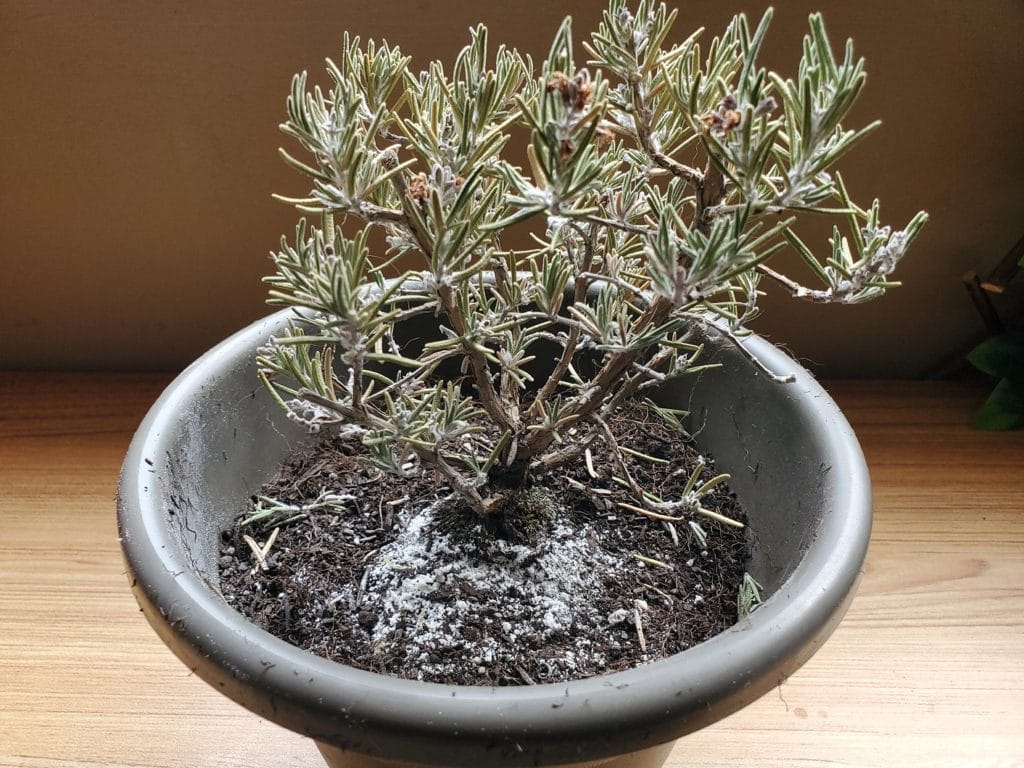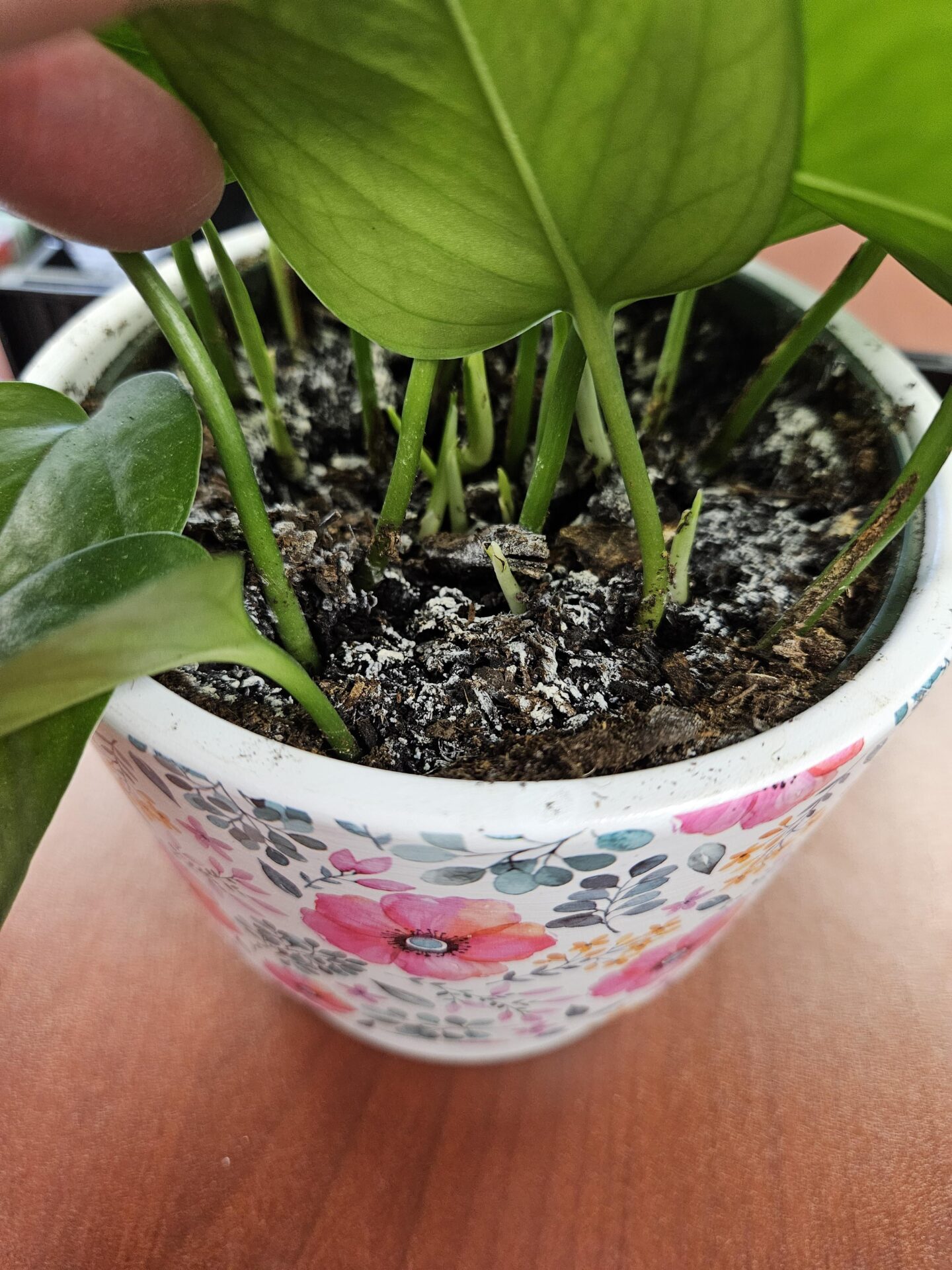Your house plant soil is turning white due to mineral buildup or mold growth. Excessive watering or poor drainage often cause these issues.
House plant soil turning white can be a common concern for many plant enthusiasts. This white residue usually results from mineral deposits left behind by hard water or fertilizers. Over time, these minerals accumulate on the soil surface, creating a white crust.
Another possible cause is mold growth, which thrives in damp, poorly-drained soil. Identifying the root cause is essential for effective treatment. Proper watering practices, good drainage, and occasional soil replacement can help maintain healthy soil conditions. Understanding these factors ensures your house plants remain vibrant and thriving.
Common Causes Of White Soil
Noticing white patches on your house plant soil can be alarming. Understanding the common causes can help you take proper actions to keep your plants healthy.
Mineral Buildup
One common cause of white soil is mineral buildup. Tap water often contains minerals like calcium and magnesium. These minerals accumulate in the soil over time. As the water evaporates, it leaves behind these white deposits. This buildup can affect your plant’s health. To prevent this, use distilled or rainwater for watering your plants.
Mold Growth
Another cause of white patches is mold growth. Mold thrives in moist, warm environments. Overwatering your plants can create these conditions. Mold appears as a thin, white layer on the soil surface. It can be harmful to your plants. Reduce watering and improve air circulation to prevent mold growth.
| Cause | Symptoms | Prevention |
|---|---|---|
| Mineral Buildup | White crust on soil | Use distilled or rainwater |
| Mold Growth | White, fuzzy layer on soil | Reduce watering, improve air circulation |
Identifying Mineral Buildup
Have you noticed a white layer forming on your house plant soil? This could be a sign of mineral buildup. Understanding the reasons behind this phenomenon helps in maintaining healthy plants.
Signs Of Hard Water
Hard water contains high levels of minerals like calcium and magnesium. These minerals can accumulate in the soil over time. Look for these signs:
- White crust on the soil surface
- White deposits on the edges of pots
- Water spots on leaves or soil
Impact On Plants
Mineral buildup can harm your plants in various ways. Here’s a table showing the impact:
| Impact | Description |
|---|---|
| Root Damage | Excess minerals can damage plant roots. |
| Nutrient Imbalance | Minerals can block essential nutrients uptake. |
| Stunted Growth | Plants may show reduced growth and vigor. |
It’s crucial to address these issues to keep your plants healthy and vibrant.
Dealing With Mold
Noticing white patches on your plant soil can be alarming. Often, these patches indicate the presence of mold. Mold thrives in damp, humid conditions and can harm your plants. Understanding the types of mold and their health risks is crucial.
Types Of Mold
There are several types of mold that can grow in plant soil. The most common types include:
- White Mold: Often looks like a thin, white layer on the soil.
- Gray Mold: Appears fuzzy and can spread quickly.
- Green Mold: Usually found on the soil surface, looking powdery.
Identifying the type of mold helps in choosing the right treatment.
Health Risks
Mold in plant soil can pose health risks. These risks can affect both your plants and your home environment.
| Risk | Description |
|---|---|
| Allergic Reactions | Some people may develop allergies to mold spores. |
| Respiratory Issues | Mold spores can cause breathing problems, especially in people with asthma. |
| Plant Damage | Mold can weaken plants, making them more susceptible to diseases. |
Keeping an eye on mold growth can protect your health and your plants.

Credit: secretlivesofplants.com
Preventing Mineral Buildup
Noticing your house plant soil turning white? This can be a sign of mineral buildup. Preventing this is essential for healthy plants. Below are effective ways to keep your soil free from harmful minerals.
Using Filtered Water
Tap water often contains minerals like calcium and magnesium. These minerals can accumulate in the soil. Using filtered water can help reduce this buildup.
| Water Type | Mineral Content |
|---|---|
| Tap Water | High |
| Filtered Water | Low |
| Distilled Water | None |
Consider using distilled water. This type of water has no minerals. You can also collect rainwater. Rainwater is another mineral-free option.
Proper Drainage
Ensuring proper drainage is another key step. Water that stays in the soil can lead to mineral buildup. Make sure your plant pots have drainage holes.
- Use pots with multiple drainage holes.
- Place a layer of rocks at the bottom of the pot.
- Avoid overwatering your plants.
Good drainage helps to flush excess minerals out. This keeps your plant soil healthier. Proper drainage also prevents root rot.
Treating Moldy Soil
Is the soil in your house plant turning white? This can be a sign of mold. Moldy soil is not good for your plants. It can harm their growth. Treating moldy soil is important for plant health. Let’s explore how to handle this.
Removing Affected Soil
First, you need to remove the affected soil. Use a small shovel. Scoop out the top layer of moldy soil. Be careful not to damage the roots. Dispose of the moldy soil in a sealed bag. This prevents mold from spreading.
Next, add fresh soil to your plant. Make sure it is clean and free of mold. Mix it well with the remaining soil. This helps the plant stay healthy.
Using Natural Fungicides
Natural fungicides can help kill mold. They are safe for your plants. Some common natural fungicides include:
- Cinnamon: Sprinkle cinnamon on the soil. It has antifungal properties.
- Apple Cider Vinegar: Mix one tablespoon with water. Spray the soil lightly.
- Baking Soda: Dissolve one teaspoon in water. Spray it on the soil surface.
Always use these remedies in small amounts. Too much can harm the plant. Test a small area first. See how your plant reacts. If it looks fine, continue treating the moldy soil.

Credit: www.reddit.com
Maintaining Healthy Soil
Keeping your house plant soil healthy is crucial for plant growth. White soil can be a sign of problems. Here’s how to maintain healthy soil.
Regular Soil Checks
Check your soil every week. Look for white crust on the surface. This could be a sign of salt buildup or mold.
Use a small shovel to dig around the plant. Check for any odd smells or textures. Healthy soil should feel loose and crumbly.
Balanced Fertilization
Fertilize your plants to keep them strong. Use a balanced fertilizer that contains nitrogen, phosphorus, and potassium. Too much fertilizer can cause salt buildup, which turns the soil white.
Follow the instructions on the fertilizer package. Over-fertilizing can harm your plants.
Consider using organic fertilizers. They release nutrients slowly and help maintain healthy soil.
| Fertilizer Type | Benefits |
|---|---|
| Organic | Slow nutrient release, improves soil structure |
| Synthetic | Fast nutrient release, easier to measure |
- Check soil weekly for white crust.
- Use balanced fertilizers.
- Follow fertilizer instructions carefully.
- Consider organic options for better soil health.
Choosing The Right Soil Mix
Picking the right soil mix is crucial for healthy house plants. The soil mix affects water retention, drainage, and nutrient supply. If your plant soil is turning white, poor soil mix could be the cause. Let’s delve into the components and custom blends of good soil.
Components Of Good Soil
A good soil mix contains several key components:
| Component | Benefits |
|---|---|
| Peat Moss | Retains moisture and provides aeration. |
| Perlite | Improves drainage and prevents compaction. |
| Vermiculite | Helps with water retention and nutrient absorption. |
| Compost | Offers essential nutrients and improves soil structure. |
Custom Soil Blends
Creating custom soil blends ensures your plants get the best environment. Here are a few popular blends:
-
General Houseplant Mix
- 2 parts peat moss
- 1 part perlite
- 1 part compost
-
Cacti and Succulent Mix
- 2 parts sand
- 1 part perlite
- 1 part peat moss
-
Orchid Mix
- 2 parts bark
- 1 part perlite
- 1 part charcoal
Each blend caters to specific plant needs, ensuring optimal growth. Observe how your plants respond to these custom mixes. Adjust components as necessary to create the perfect soil mix for your houseplants.
Monitoring Plant Health
Monitoring the health of your house plants is essential for their growth. If the soil turns white, it could indicate underlying issues. Understanding these signs can help you address problems quickly.
Signs Of Stress
White soil can signal stress in your plants. Look for these common signs:
- Wilting Leaves: Drooping or limp leaves may point to poor soil health.
- Yellowing: Leaves turning yellow suggest nutrient deficiency or water issues.
- Stunted Growth: Slow growth can indicate a problem with the soil.
- Brown Tips: Leaf tips turning brown could mean salt buildup in the soil.
Routine Care Tips
Proper care can prevent the soil from turning white. Follow these tips:
- Watering: Water your plants regularly but avoid overwatering. Overwatering can cause mold.
- Drainage: Ensure pots have drainage holes. Good drainage prevents salt buildup.
- Fertilizing: Use balanced fertilizer. Excess fertilizer can lead to white crust on the soil.
- Cleaning: Wipe the plant leaves to remove dust and allow them to breathe.
| Care Aspect | Action |
|---|---|
| Watering | Regular, avoid overwatering |
| Drainage | Ensure proper drainage |
| Fertilizing | Balanced, avoid excess |
| Cleaning | Wipe leaves regularly |

Credit: www.reddit.com
Frequently Asked Questions
How To Get Rid Of White Mold On Plant Soil?
Remove the moldy soil’s top layer. Increase ventilation and sunlight. Reduce watering frequency. Use a fungicide if needed.
Why Does The Soil In My House Plants Turn White?
The soil in house plants turns white due to mineral buildup from tap water or fertilizer. Salts accumulate on the soil’s surface.
Is White Mold In Potting Soil Bad?
White mold in potting soil is usually harmless. It often indicates overwatering or poor ventilation. Adjust watering and improve airflow.
How Do I Get Rid Of The White Stuff In My Potting Soil?
Remove white mold by scraping it off. Improve drainage and reduce watering. Use a fungicide if necessary.
Conclusion
Understanding why your house plant soil turns white is crucial. It often indicates mineral buildup or mold. Regularly check and maintain your plants to prevent this issue. Use filtered water and ensure proper drainage. With these simple steps, you can keep your house plants healthy and thriving.

My mission is to help you bring the beauty of nature indoors with expert advice, detailed plant care guides, and creative design ideas.





Leave a Reply